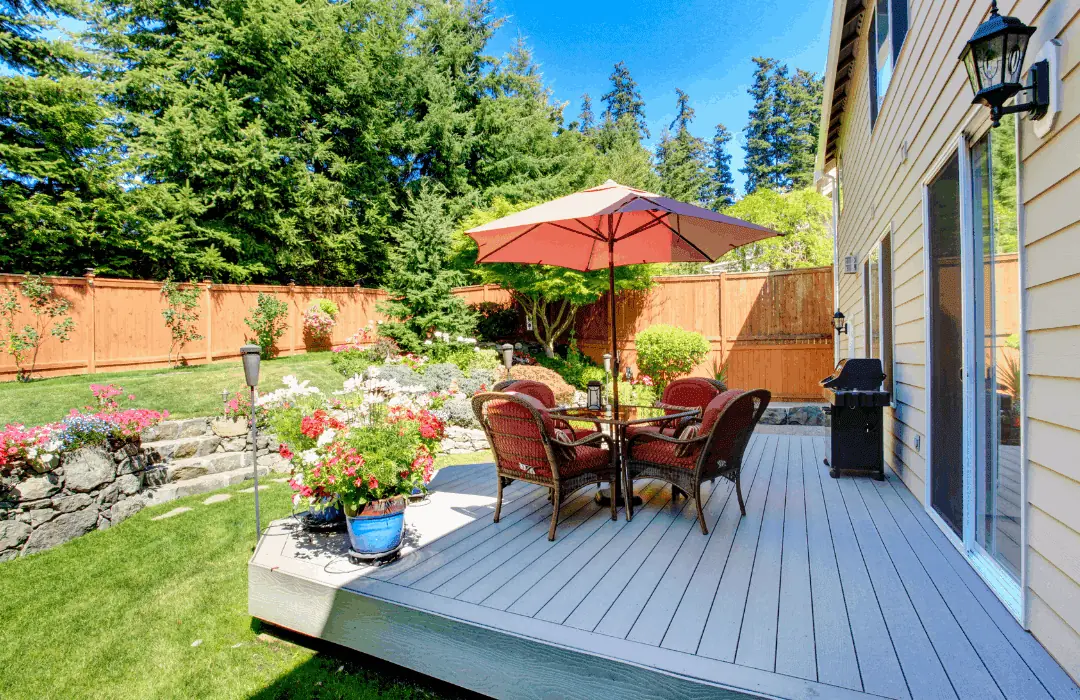WHICH MATERIAL IS RIGHT FOR YOUR HARDSCAPING PROJECT?

If you’ve decided to make the investment in a new outdoor living space, you naturally want to make certain that you choose the right materials. You want something that looks great and something that will stand the test of time. For some homeowners, using materials that will enhance their home’s resale value is also an important consideration. While still others seek low maintenance materials as they want to do little more than relax in their outdoor oasis. There are four primary materials used in most hardscaping projects. Here’s an overview to help you understand each and the options they present.
Concrete
Concrete is typically the most affordable choice for hardscaping projects. A natural color, broom-finished concrete slab is the most basic and least costly of all concrete options. A simple concrete slab can be colored, either by a dry or liquid pigment or by staining a finished slab.
A more labor-intensive process is used to create exposed aggregate concrete. With this finish, the installer presses a layer of small aggregate (stones) into the top of the pour, and then washes the concrete away from the stones in the top layer, leaving a unique, textured finish.
The most expensive type of concrete for hardscapes is stamped concrete. With this finish, pigments are dusted artfully over the concrete after the slab is poured. Stamps are then used to create impressions that can look like brick, stone, or even wood planks.
Concrete’s lower cost is certainly a virtue. One concern some homeowners have with concrete is that cracks and chips are hard to repair, and a damaged surface may expose a completely different color beneath.
Concrete pavers
Concrete pavers have become a popular choice for homeowners for several reasons. First, they offer a wide array of price points. Next, many pavers are durable enough as to be rated for use on driveways and even roads; and finally, there are numerous design options. Concrete pavers may be shaped like traditional bricks, cobblestones, large slabs, and even irregular flagstone pieces. Many manufacturers even offer permeable pavers, which allow rainfall to percolate back into the groundwater, removing pollution and impurities in the process.
Concrete pavers are simple to maintain, and repair is easy as well. If an individual paver is damaged, you simply remove that one paver and replace it with a new one. Twenty years ago pavers may have presented some maintenance issues as the sand in the joints needed replaced, but that’s no longer a concern as polymeric sand is used in paver joints, creating a flexible joint that won’t wash out.
Flagstone
Flagstone is what many people think of when they consider a stone patio. The type of stone can vary depending on where you are in the country, creating a true sense of place. In the Southwest you may see buffs, tans, and even reds in regionally-quarried stone. In the Midwest, you’ll see tans, browns, and grays. On the East Coast, the colors of Pennsylvania flagstone - grays tinged with blues, greens, and rust - dominate. As hardscaping has gone global, you can even find more unusual colors on flagstone imported from Asia and South America.
Quality flagstone of an appropriate thickness for the given application results in a durable, beautiful product. Thicker pieces may be “dry laid,” meaning that they are set on a bed of sand or stone dust and not mortared into place. Flagstone can also be wet laid, meaning it’s bonded to a concrete slab with mortar and the joints are grouted. Which to choose depends on budget, aesthetics, and site conditions.
Travertine pavers
If you love the look of marble indoors, it may surprise you to learn that you can bring that look outside as well. Travertine pavers are rectangular pieces of marble typically cut to a one inch thickness. Believe it or not, travertine has sufficient such compressive strength that it has been used for driveways! Colors generally range from white and cream to golds, silvers, and even yellow-orange. Travertine pavers can be dry laid or wet laid, much like flagstone.
Which material is right for your hardscaping project? You’ll need to consider your budget, the look you’re after, and what’s suited to your region and your individual property. Your landscape professional can walk you through the options and help you make the decision that’s right for you.





















